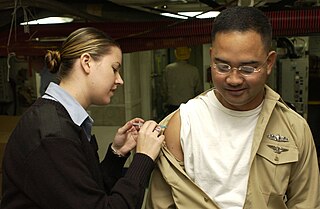Control measures
Antiviral stockpile
In addition to oseltamivir, CECC also procured zanamivir for the pandemic. [25] [26] The first shipment of stockpiled antivirals was released on August 29. [27] All medication was paid by the National Health Insurance.[ citation needed ]
Medical care system

On August 17, 2009, Taiwan CDC published the "Clinical Treatment Guideline for Influenza A(H1N1)", which is a result of collaborative work with the Infectious Diseases Society of Taiwan, Taiwan Pediatric Association, Nosocomial Infection Control Society of Taiwan and Taiwan Society of Pulmonary and Critical Care Medicine. [28] Guidelines on diagnosis, treatment and control of nosocomial infection are included. According to the guideline, oseltamivir is suggested to be given to patients with influenza-like illness and a positive rapid influenza diagnostic test result, patients with complicated influenza and patients with high risk conditions as defined by the WHO. [29] National Health Insurance, a compulsory social insurance system, is covering >98% of the population and contracting with >90% of the medical care institutions in Taiwan. [30] Since August 15, 2009, oseltamivir can be prescribed free of charge in more than 3500 contracted clinics/hospitals for patients fulfilling the above criteria. Furthermore, the Taiwan Medical Association indicated that the doctors would help ease the load of patients by having clinics open on weekends. [31]
Vaccination
On June 1, the CECC began the process to procure influenza A(H1N1) vaccine. [32] As a result, 15 million doses of vaccine were bought from two manufacturers (Adimmune and Novartis), covering 60% of the population. [33] Vaccine priority list was announced in August and mass vaccination began on November 1. Vaccinations were first given to targeted high risk groups, and to school aged children who are likely to spread the disease. [34] [35] Medical personnel were the first to be immunized. Data from a cross-national study showed that 76% of physicians in Taiwan have been vaccinated, which was the highest among all the physicians interviewed. [36]
National Immunization Day
On December 12, 2009, vaccination was opened up to everyone. A large vaccination campaign was conducted to boost vaccination coverage. Vaccination stations were set up in hospitals, clinics, department stores and community gathering places. A total of 563,712 doses of vaccines (2.4% of population) were administered on that day. [37] [38] By the end of January 2010, approximately 24% of the total population have been immunized. To improve the accessibility of vaccination, phone lines set up by local health bureaus in cities and counties are open for the public to book a group appointment for pandemic influenza A (H1N1) vaccination. [39] To prevent further spread of the virus in the coming 9-day holiday of the Chinese New Year, immunization stations were set up in airports and Taipei Station to vaccinate travellers since February 1, 2010.[ citation needed ]
Surveillance for adverse events following immunization
To ensure and safety and effectiveness of H1N1 vaccine, Taiwan CDC has passive and active surveillance system for vaccine adverse events. For passive surveillance, any adverse event happens after H1N1 immunization can be reported to local health bureau and Taiwan CDC. For active surveillance, vaccination record database is linked with the National Health Insurance database to ensure that the incidence of neurological diseases (such as Guillain–Barré syndrome), cardiovascular disease, adverse pregnancy outcome, stroke and anaphylaxis does not exceed the background incidence. By January 26, 2010, 1176 suspected vaccine-related adverse events have been reported, including 330 suspected serious adverse events and 35 deaths. Based on the number of vaccine doses administered, the incidence of adverse events and serious adverse events did not exceed the expected value. [40] Vaccine Injury Compensation Program (VICP) committee is composed of a group of expert consultants with expertise in clinical medicine, pathology, sociology and law. It works independently from the government and is responsible for reviewing petitions requesting compensation for individuals thought to be injured by a vaccine. [41] As of January 29, 2010, the VICP has received a total of 218 claims requesting compensation for individuals thought to be injured by the pandemic influenza A (H1N1) vaccine. VICP has completed reviewing 39 petitions. Five cases were ruled compensable (association is confirmed in one while association cannot be excluded in the other four) while the other thirty-four cases were ruled non-compensable. [42]
School closures
In the beginning of the pandemic, the strategy was to contain the disease. During containment, one case was found in a school-aged child, resulting in the suspension of classes for the entire school. [43] After school re-commenced in the fall, instead of closing the entire school, it was decided that only classrooms with two or more students with influenza in a 3-day period would have classes suspended for 5 days, which is the so-called 325 rule for class suspension. [44] [45] School-based vaccination program started on November 16, 2009, and half of the students in elementary or junior high school were vaccinated against flu by the end of November. Therefore, the rule for class suspension shifted from 325 to "814". Class suspension is no longer indicated, if >80% of the students in a class have been vaccinated for more than 2 weeks. The number of suspended classes reached its peak by the end of November, when more than 2000 classrooms were suspended daily all over Taiwan. However, because of successful school-based immunization program, less than 5 classrooms were suspended daily by the end of 2009.[ citation needed ]









